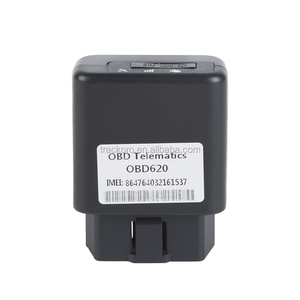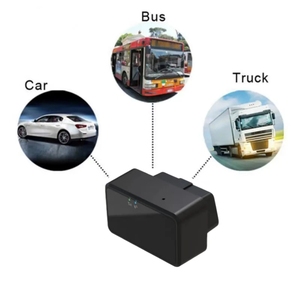(78 products available)









































































































































































































J1708 GPS OBD telematics is a vehicle communication standard that allows the exchange of information between the vehicle and external devices. It is commonly used in commercial vehicles for monitoring and diagnostics. There are two main types of J1708 GPS OBD telematics:
J1708 telematics
J1708 telematics use a two-wire twisted pair of cables to connect devices. It is a low-speed network that transmits data at a rate of 10 kbps. J1708 telematics are widely used in heavy-duty trucks for monitoring and diagnostics. They provide real-time information about the vehicle's status and performance. This information can be used for maintenance, fuel efficiency, and tracking. J1708 telematics have a low power requirement. They can be powered from the vehicle's battery or an external power source. These telematics use a simple connection method to enable communication between devices. They use a twisted pair of wires to connect the devices. This allows for reliable communication with minimal interference.
GPS OBD telematics
GPS OBD telematics combine GPS technology with OBD telematics. They use the OBD port to connect to the vehicle and the GPS satellite to provide location information. GPS OBD telematics provide real-time tracking and location information. Users can track the vehicle's location and monitor its movement in real time. This information is helpful for logistics, fleet management, and theft prevention. GPS OBD telematics use advanced data processing techniques to provide accurate and reliable information. They can process data from the vehicle's sensors and the GPS signal to provide real-time information about the vehicle's status and location.
Regular Inspection
Perform regular inspections of the telematics device and the connected OBD port to ensure there are no physical damages or loose connections. Check the wiring and connectors for any signs of wear or corrosion that could affect data transmission.
Software Updates
Stay up-to-date with the latest software updates for the telematics device. Manufacturers often release updates to improve performance, add new features, or address any security vulnerabilities.
Data Security
Implement measures to ensure the security of the data transmitted and received through the telematics device. Use encryption protocols, secure access controls, and regularly update passwords to protect against unauthorized access to sensitive information.
Environmental Considerations
Consider the environmental conditions where the telematics device is used. Extreme temperatures, humidity, or exposure to harsh elements can affect the device's performance. Choose a device designed to withstand the environmental conditions of the operating area.
Data Usage Monitoring
Monitor the data used by the telematics device to ensure it stays within the limits of the selected plan. Excessive data usage can result in additional charges. Identify and address any issues that may cause increased data consumption, such as frequent location updates or excessive event reporting.
Device Performance Monitoring
Regularly monitor the performance of the telematics device to ensure it operates efficiently. Track key performance indicators such as data accuracy, transmission frequency, and device response time. If performance issues arise, troubleshoot the device or contact the manufacturer for support.
Compliance with Regulations
Stay informed about the legal requirements related to telematics and GPS tracking in the operating area. Ensure the device complies with data privacy, security, and other relevant regulations.
Training and Awareness
Provide training and awareness programs for employees or users of the telematics device. Educate them about the device's features, data security best practices, and the importance of accurate data reporting.
Here are some key considerations when selecting a suitable J1708 GPS OBD telematics device:
Identify business needs
Understand the business's specific needs before purchasing a telematics device. Businesses with a large fleet may want to track the car's location and monitor the driver's behavior. While companies concerned about their carbon footprint may want to track their vehicles' fuel efficiency.
Device compatibility
Not all vehicles are compatible with all telematics devices. Ensure the device is compatible with the car's make, model, and year. Additionally, the device should be compatible with the business's mobile operating system.
Data security
Telematics devices collect and transmit sensitive business data. Therefore, choosing a device with strong data security measures is essential. Look for devices with encryption and secure data transmission.
Ease of installation
Some telematics devices require professional installation, while others can be self-installed. Consider how much the business is willing to spend on installation and whether it prefers a quick and easy installation or is okay with a more extended installation process.
Data accuracy
The accuracy of the data collected by the telematics device is an essential consideration. Inaccurate data can lead to poor decision-making and can negatively impact the business's bottom line. Therefore, choosing a device known for its data accuracy is essential.
Customer support
Good customer support is essential when choosing a telematics device. Look for suppliers who offer prompt technical support, regular software updates, and a responsive customer service team.
Device cost
The cost of the telematics device is an important consideration for many businesses. Devices with advanced features tend to be more expensive. Therefore, choosing a device that meets the business's needs without breaking the bank is essential.
Scalability
If the business plans to grow, it is essential to choose a scalable telematics device. The device should be able to add more features and track more vehicles as the business grows.
Reporting and analytics
Choose a telematics device with robust reporting and analytical capabilities. The device should provide real-time data and detailed reports to help the business make informed decisions.
Trial period
Some telematics device providers offer a trial period. This allows the business to test the device and its features before purchasing it. If possible, choose a provider who offers a trial period.
Most J1708 GPS OBD telematics devices are plug-and-play. They are easy to install, and the installation instructions are straightforward. However, some require a bit of technical know-how. Here is how to install and replace the device:
To replace the telematics device, first, disconnect it from the OBD-II port and remove it from the vehicle. Then, follow the above installation steps to install the new one.
Q1: Is the J1708 GPS OBD telematics device easy to install?
A1: The J1708 GPS OBD telematics device is designed to be installed quickly and easily on a vehicle's onboard diagnostics (OBD) port. Generally, the installation process takes a few minutes. Once installed, the device can provide real-time data and access various telematics services. However, the exact installation time may vary depending on the specific model and other factors. For example, some advanced models may require more time to install and configure.
Q2: Can the J1708 GPS OBD telematics device be used in commercial vehicles?
A2: J1708 GPS OBD telematics devices are designed for passenger cars but can also be installed on commercial vehicles. For example, fleet managers can install the device on commercial vehicles to track real-time location data, monitor vehicle health and performance, and access various telematics services. The device can provide valuable data and insights, helping optimize fleet operations, improving efficiency, and reducing costs.
Q3: What are the main benefits of using the J1708 GPS OBD telematics device?
A3: The J1708 GPS OBD telematics device can provide various benefits, including real-time location tracking, monitoring vehicle health and performance, accessing various telematics services, and easy installation. As a result, it can track the vehicle's health, performance, and location, optimally managing logistics and reducing costs. For example, fleet managers can install the device on commercial vehicles to track real-time location data, monitor vehicle health and performance, and access various telematics services.
Q4: Do users need data plans or subscriptions to use the J1708 GPS OBD telematics device?
A4: Users may require data plans or subscriptions to use the J1708 GPS OBD telematics device. For example, maintaining a cellular network connection is necessary to access real-time data and telematics services. In addition, some models of the J1708 GPS OBD telematics device may require data plans or subscriptions to access specific features or services. Therefore, users should check the specific model's requirements and the telematics services provider's offer.